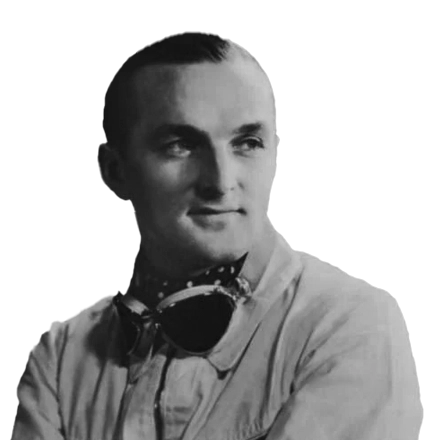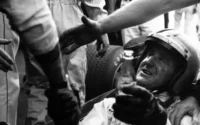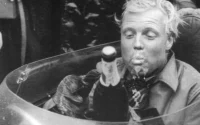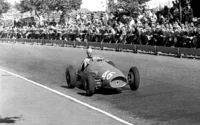Hermann Lang was a German racing driver whose remarkable career spanned motorcycles, Grand Prix cars, and endurance sports cars. Rising from humble beginnings as a mechanic, Lang’s story is one of talent and triumph against the odds, culminating in his transformation from factory worker to Mercedes-Benz Grand Prix winner.
| Nationality | German |
|---|---|
| Born | 6 April 1909 Cannstatt, Kingdom of Württemberg, German Empire |
| Died | 19 October 1987 (aged 78) Bad Cannstatt, Baden-Württemberg, West Germany |
Born in Cannstatt near Stuttgart, Lang grew up in modest circumstances. After his father’s death, the young Hermann left school at just fourteen to support his family, finding work as a motorcycle mechanic. Fascinated by speed, he saved enough to buy his own second-hand bike—and promptly won the first race he ever entered. Soon after, he switched to sidecar racing, where his blend of courage and technical understanding paid off. By the age of twenty-two, he had captured the German Sidecar Mountain Race Championship.
Lang’s fortunes changed dramatically when he secured a position at the Mercedes-Benz factory. His mechanical skill quickly earned him a spot on the company’s prestigious Grand Prix racing team as head mechanic for Luigi Fagioli’s Mercedes-Benz W25A. Working alongside stars like Rudolf Caracciola, Lang absorbed everything he could about racing’s elite world. His big break came when he was given the opportunity to drive—and he seized it with both hands.
Lang’s first major victory came at the 1937 Tripoli Grand Prix in Libya, held on what was then the world’s fastest circuit. It was the beginning of a streak—he won the event three years in a row. That same year, he also triumphed at the AVUS race in Berlin, further solidifying his place among the sport’s rising stars.
In 1938, Lang continued his momentum with wins at the Coppa Ciano in Livorno and other European events. Yet despite his success, Lang often found himself an outsider within the Mercedes Silver Arrows team, whose ranks were filled with aristocratic drivers who looked down on his working-class background. Nevertheless, in 1939, his performances could no longer be ignored: Lang won five of the eight Grand Prix he started, including the Belgian, Swiss, Pau, and Tripoli Grands Prix, plus the Kahlenberg Hillclimb in Austria. His mechanical insight—sharpened by years as a technician—made him invaluable to Mercedes’ chief engineer Rudolf Uhlenhaut, and Lang’s cars were often the best-tuned in the field.
The 1939 Championship Controversy
That same year, Lang was declared European Champion by Germany’s national motor racing authority. However, the season was abruptly halted by the outbreak of World War II, and the official governing body, the AIACR, never ratified the results. Some historians credit Hermann Paul Müller as the rightful points leader, leaving Lang’s title in historical dispute—but few doubted that he had been the dominant driver of 1939.
Postwar Comeback
The war robbed Lang of his prime racing years, but his passion never waned. In 1946, he made a comeback, winning the first postwar race held in Germany at Ruhestein, driving an aging BMW. He later turned his attention to sports car racing and Formula Two, before rejoining Mercedes-Benz for their Grand Prix return at the 1951 Buenos Aires Grand Prix.
A year later, at age 43, Lang achieved one of the crowning moments of his career—teaming up with Fritz Riess to win the 1952 24 Hours of Le Mans, delivering a triumphant comeback victory for Mercedes. In 1953, he briefly joined Maserati in Formula One, finishing a commendable fifth at the 1953 Swiss Grand Prix.
When Mercedes re-entered Grand Prix racing in 1954, Lang returned to the fold once more, piloting the now-legendary Mercedes W196. Though nearing the end of his competitive years, he still showed flashes of brilliance—running as high as second in the 1954 German Grand Prix at Nürburgring before spinning out after ten laps. Realising it was time, Lang retired from competition that year, closing the book on a career that had spanned more than two decades.
After hanging up his helmet, Hermann Lang returned to work at Mercedes-Benz, the company that had shaped his life from start to finish.
Hermann Lang Formula One World Championship career
| F1 Career | 1953–1954 |
|---|---|
| Teams | Maserati, Mercedes |
| Entries | 2 |
| Championships | 0 |
| Wins | 0 |
| Podiums | 0 |
| Career points | 2 |
| Pole positions | 0 |
| Fastest laps | 0 |
| First entry | 1953 Swiss Grand Prix |
| Last entry | 1954 German Grand Prix |
Hermann Lang Teammates
| 5 drivers | Involvement | First Year | Last Year |
|---|---|---|---|
| Juan Manuel Fangio | 2 | 1953 | 1954 |
| Felice Bonetto | 1 | 1953 | |
| Onofre Marimon | 1 | 1953 | |
| Hans Herrmann | 1 | 1954 | |
| Karl Kling | 1 | 1954 |




